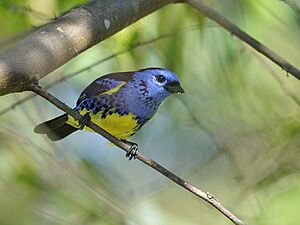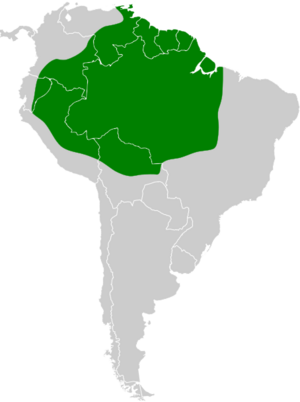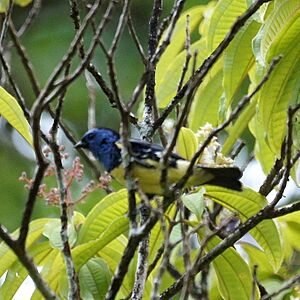Turquoise tanager facts for kids
Quick facts for kids Turquoise tanager |
|
|---|---|
 |
|
| Conservation status | |
| Scientific classification | |
 |
|
| Range | |
| Synonyms | |
|
Tanagra mexicana Linnaeus, 1766 |
The turquoise tanager (Tangara mexicana) is a beautiful, medium-sized bird. It belongs to the tanager family, called Thraupidae. These colorful birds live in places like Trinidad, much of Brazil, Colombia, and Venezuela. You can find them south to Bolivia. Even though its scientific name includes "mexicana," it does not live in Mexico!
Turquoise tanagers love humid forests, especially the Amazon. They also live in woodlands and even some cultivated areas. These birds are quite social and are often seen in groups. They enjoy eating many different kinds of fruit. They also hunt for insects and other small creatures, often picking them off twigs.
When it's time to nest, the female builds a cup-shaped nest in a tree or bush. She lays about three grey-green eggs with brown spots.
What Does the Turquoise Tanager Look Like?
Adult turquoise tanagers are about 14 centimeters (5.5 inches) long. They weigh around 20 grams (0.7 ounces). They have a long tail and a strong, pointed dark beak.
Most of their body is a mix of dark blue and black. Their wing feathers, called primaries, have pretty turquoise edges. Many types of turquoise tanagers have yellow feathers on their lower belly. However, the type found in northeastern South America has paler, more cream-colored underparts.
The birds living in Trinidad, known as the T. m. vieiloti subspecies, look a bit different. They have a darker blue head and chest. Their yellow underparts are much brighter than those of the birds on the mainland. When they sing, you'll hear a fast, squeaky sound like "tic-tic-tic-tic-tic."
Where Do They Live?
The turquoise tanager lives in several countries in South America. They are found in Trinidad, Colombia, Venezuela, and Brazil. Their home extends south into Bolivia. These birds prefer areas with lots of moisture, like humid forests. The largest group of them lives in the vast Amazon rainforest.
How Are They Grouped?
Scientists group animals to understand them better. The turquoise tanager is part of the Tangara group of birds. There are four main types, or subspecies, of the turquoise tanager:
- T. m. vieilloti: This type lives in Trinidad.
- T. m. media: You can find this type in eastern Colombia and Venezuela.
- T. m. mexicana: This type lives in the Guianas and central Brazil.
- T. m. boliviana: This type is found from southeastern Colombia to eastern Ecuador, eastern Peru, western Brazil, and northern Bolivia.
Another bird, the white-bellied tanager (Tangara brasiliensis), used to be considered a type of turquoise tanager. But now, scientists see it as its own separate species.



